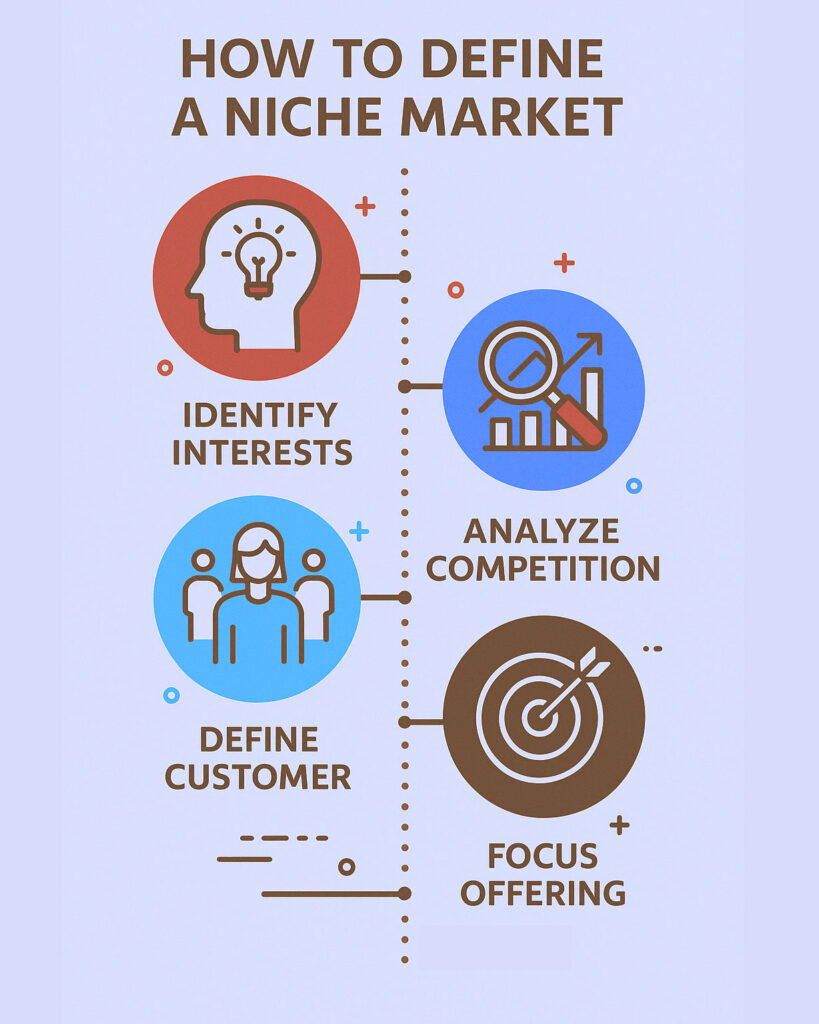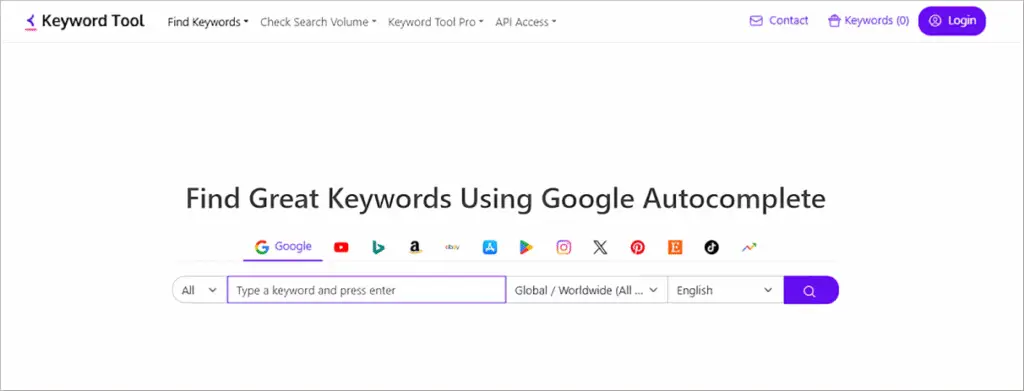Niche Marketing: Strategies, Benefits, and Future Trends for 2025 and Beyond
Marketing has become one of the most dynamic and adaptive industries in the digital age. From rapid tech evolution to consumer behavior shifts, brands are constantly reinventing how they reach and engage with their audiences. Amid this change, one strategy continues to gain momentum: niche marketing.
Often overlooked by newcomers in the entrepreneurial world, niche marketing has proven to be a powerhouse tool for both startups and established businesses. Unlike broad-scale marketing, which casts a wide net, niche marketing is like using a laser—highly focused, precise, and impactful.
In this comprehensive guide, we’ll dive deep into niche marketing—what it is, how it works, its growing relevance in 2025, strategies to implement it effectively, and future trends shaping its trajectory.
What is Niche Marketing?
Niche marketing is the process of targeting a specific subset of the market that shares distinct characteristics, needs, or interests. Rather than promoting to the general population, businesses create tailored campaigns for a narrowly defined audience segment.
This segment could be based on various criteria:
- Demographics (e.g., age, income, gender)
- Interests (e.g., vegan skincare, smart home gadgets)
- Behavior (e.g., frequent travelers, remote workers)
- Location (e.g., eco-conscious consumers in urban areas)
The core goal is simple: focus your efforts on an audience that’s more likely to engage, convert, and stay loyal.
The Evolution of Niche Marketing in the Digital Age
Niche marketing isn’t new, but the digital revolution has redefined its role in modern business. A decade ago, niche marketing was mostly associated with limited advertising budgets and modest reach. Fast-forward to today, and it’s a foundational strategy used by global brands and agile startups alike.
Here are the two biggest catalysts that transformed niche marketing:
1. Rise of Social Media Platforms
Social media platforms have become hubs for niche communities. Whether it’s fitness enthusiasts on Instagram, gamers on Twitch, or DIY crafters on Pinterest, digital spaces allow brands to find, engage, and grow micro-communities around shared interests. Algorithms reward relevance and engagement, so niche content is more likely to perform well.
2. Artificial Intelligence and Personalization Tools
AI has revolutionized marketing automation and personalization. Brands can now use tools to analyze user behavior, preferences, and intent at scale. AI-powered CRMs and analytics tools help segment audiences down to micro-niches, allowing marketers to craft hyper-personalized messages and product recommendations.
A report from HubSpot shows that 74% of consumers feel frustrated when website content isn’t personalized. This statistic underlines the importance of relevant messaging—something niche marketing excels at.
Why Niche Marketing Matters More Than Ever in 2025
As markets grow increasingly saturated and consumer attention spans shorten, brands can no longer afford to be generic. Here are the major reasons niche marketing is essential today:
1. Personalized Offers Drive More Engagement
Customers crave personalization. Mass marketing often feels cold and impersonal, while niche marketing offers tailored solutions that resonate deeply. When you know your audience’s pain points, values, and desires, your messaging becomes more relatable—and effective.
Example: A skincare brand that targets people with rosacea and sensitive skin is likely to generate more meaningful engagement than one with a general “for all skin types” approach.
2. Cut Through the Digital Noise
With billions of pieces of content being published every day—from tweets and reels to blog posts and newsletters—grabbing attention is tough. Niche marketing gives you a competitive edge by narrowing your focus. Instead of shouting into the void, you’re speaking directly to those who are most interested.
3. Social Media Favors Specificity
Algorithms on platforms like TikTok, YouTube, and Instagram prioritize content that aligns with users’ interests. Content made for a niche community tends to generate more likes, shares, and comments because it feels more personal and targeted.
Example: A TikTok channel dedicated to vintage camera reviews will attract more relevant followers than a general tech account.
4. Stronger Customer Loyalty and Retention
When brands serve a niche audience well, they build emotional connections. Consumers feel seen and understood, which leads to trust. Loyal customers are not only repeat buyers—they become advocates who spread the word organically.
5. Higher Return on Investment (ROI)
Because niche marketing focuses only on relevant leads, businesses avoid wasting resources on uninterested audiences. The result? Higher conversion rates, lower ad spend, and improved overall ROI.
How to Define Your Niche Market

Defining a niche market requires a mix of research, introspection, and strategy. Here’s a step-by-step process to help:
1. Choose an Industry
Start broad by identifying the industry you want to enter. This could be fashion, tech, health, travel, education, finance, or any other sector. From there, drill down to find unique areas within that industry.
Example: Within the fitness industry, a niche might be “postpartum fitness for new moms.”
2. Identify Gaps in the Market
Study the current landscape. Are there underserved communities? Problems that haven’t been solved effectively? Look at what competitors offer—and more importantly, what they don’t.
Tools like Google Trends, Reddit threads, Amazon reviews, and keyword research platforms can help uncover untapped opportunities.
3. Focus on a Specific Audience Segment
Define who your audience is by considering:
- Age
- Location
- Income level
- Hobbies
- Lifestyle
- Pain points
The more specific you are, the better your chances of creating a product or service that feels tailor-made for them.
4. Develop a Unique Value Proposition
Your product or service must offer something others don’t. Ask yourself: Why should your niche audience choose you? What sets you apart?
Example: A coffee brand that sources beans from women-owned farms in South America speaks to both coffee lovers and socially conscious consumers.
5. Analyze Competitors
Study the existing players in your chosen niche. What are they doing well? Where are they lacking? Use competitor analysis tools like SEMrush, Ahrefs, and ContentStudio to examine content, social strategy, keywords, and audience engagement.
6. Test and Validate
Before going all-in, validate your niche idea. Launch a minimal viable product (MVP), run small ad campaigns, or create targeted content to test engagement. Use the feedback to iterate and refine.
How to Identify Your Niche Market

Identifying your niche market is about understanding both your audience and yourself. Here’s how to do it:
Understand Your Interests or Expertise
Start with what you know or love. Building a business in a space you’re passionate about not only keeps you motivated but also helps build authenticity and authority.
Example: A personal trainer with a passion for mental health might niche down into “fitness coaching for people dealing with anxiety.”
Research Your Audience
Find where your audience hangs out—Facebook groups, LinkedIn communities, subreddits, YouTube comment sections, or Discord servers. Listen to their problems, observe their language, and note what types of content they engage with.
Study the Competition
Look at successful players in your potential niche. What kind of content are they posting? What kind of engagement are they receiving? This gives you insight into the demand and potential differentiation points.
Identify Specific Problems You Can Solve
The more specific the problem, the more valuable your solution. Think in terms of outcomes, not features. What transformation does your product or service offer?
Example: “We help college students on a budget cook healthy meals in 15 minutes.”
Run Micro-Experiments
Create sample content (videos, blog posts, product mockups), host a webinar, or launch a landing page. Collect responses, survey feedback, and track metrics like click-through rates and sign-ups.
Refine Over Time
Niches aren’t static. As you learn from your audience, refine your approach. It’s normal to pivot slightly based on real-world feedback and evolving market demands.
Proven Strategies for Niche Marketing Success
Once you’ve defined your niche, it’s time to market it effectively. Here are actionable strategies:
1. Build a Strong Brand Identity
Your brand should reflect the values, tone, and aesthetic of your niche. From logo to language, everything should align with your audience’s expectations.
2. Use Storytelling to Build Connection
Stories are powerful. Share personal journeys, customer testimonials, and behind-the-scenes content. Authenticity resonates deeply within niche communities.
3. Leverage Influencer Collaborations
Partner with micro or nano-influencers in your niche. Their followers trust their recommendations, making it easier to introduce your brand.
4. Focus on SEO for Long-Tail Keywords
Niche audiences often search with specific queries. Optimize your blog posts, YouTube videos, and product pages for long-tail keywords.
Example: Instead of “best running shoes,” use “best running shoes for flat feet women 2025.”
5. Create Community-Driven Content
Encourage user-generated content, conduct polls, host live Q&As, and foster discussion. Building community increases trust and keeps people engaged.
6. Provide Exceptional Customer Support
When serving a niche audience, every interaction matters. Personalized and responsive support enhances loyalty and sets you apart from competitors.
Future Trends in Niche Marketing
Looking ahead, niche marketing is set to become even more relevant. Here are emerging trends to watch:
1. Hyper-Personalization with AI
AI will enable even deeper segmentation and personalization. Tools will predict user needs and tailor content or products before the user even asks.
2. Rise of Private Communities
Brands will shift toward exclusive, value-driven communities—think paid Discord groups, Slack channels, or private forums—to nurture niche audiences.
3. Voice and Visual Search
With the rise of smart assistants and visual platforms like Pinterest and TikTok, niche marketers must optimize for visual cues and spoken keywords.
4. Ethical and Value-Based Niches
Consumers are becoming more values-driven. Niches rooted in sustainability, diversity, mental health, or social justice will see rapid growth.
5. Interactive Content Will Dominate
Quizzes, interactive videos, AR experiences, and live shopping events will help brands engage niche audiences in more immersive ways.
Key Benefits of Niche Marketing
1. Superior Audience Targeting
One of the most powerful advantages of niche marketing is its laser focus. By honing in on a narrow segment of the market, businesses can better understand and cater to the exact needs, desires, and behaviors of their ideal customers. This specificity leads to marketing messages that resonate more deeply, significantly boosting engagement rates and brand relevance.
For instance, a fitness brand focusing solely on postnatal mothers can create workout plans, meal ideas, and content that speaks directly to this group’s lifestyle and challenges, resulting in much higher conversion rates than a generalized fitness campaign.
2. Reduced Market Competition
Broad markets are usually saturated with established players, making it tough for new entrants to stand out. Niche markets, however, tend to have fewer competitors due to their specialized nature. This makes it easier for brands to carve out their own space and gain visibility without battling corporate giants with massive budgets.
For small businesses and entrepreneurs, this translates into a faster route to market recognition and brand authority.
3. Increased Customer Loyalty
Niche customers often feel more valued when a brand directly addresses their unique preferences and concerns. This sense of recognition and personalization builds emotional connections and trust—two crucial ingredients for customer loyalty.
As these customers develop a strong affinity with the brand, they’re more likely to make repeat purchases, advocate for the brand through word-of-mouth, and even defend it in online communities.
4. Cost-Efficient Marketing
Marketing to a broad audience requires significant investment across multiple platforms, which may not yield the best ROI. Niche marketing, on the other hand, is inherently more budget-friendly. With hyper-targeted campaigns, brands can minimize ad spend by reaching only the people most likely to convert.
Whether it’s through SEO, email marketing, or paid social ads, niche campaigns allow businesses to get the most out of every marketing dollar.
5. Stronger Brand Authority and Expertise
Positioning your brand as a specialist in a specific domain enhances your credibility. When you focus on one area, you become deeply familiar with its trends, pain points, and customer behavior. This allows you to offer informed solutions and thought leadership content that further cements your reputation as an expert.
Over time, this specialized approach earns you a respected voice within your niche—one that people listen to, trust, and recommend.
6. Streamlined Product Development
Developing products in a niche space becomes significantly easier because you have a clearer understanding of customer demands. Since your audience is more defined, you can create or tailor offerings that directly align with their needs, preferences, and feedback.
This reduces the risk of launching irrelevant products and increases the likelihood of a product-market fit.
7. Higher Conversion Rates
The combination of precise targeting, high relevance, and personalized messaging generally leads to more meaningful interactions and better conversion rates. Since you’re not casting a wide net but rather fishing in a pond filled with ideal customers, each lead is more qualified and more likely to convert into a sale.
Potential Challenges of Niche Marketing
While niche marketing offers many advantages, it’s not without its challenges. Let’s break down some of the key obstacles you may encounter.
1. Limited Audience Size
By definition, niche markets are small and specific, which can limit the total size of your potential customer base. This can present scalability issues, especially if the business model depends on volume.
To mitigate this, brands should either explore adjacent sub-niches or offer premium-priced products to increase revenue per customer.
2. Slower Growth Curve
Unlike mass market campaigns that may go viral or generate large spikes in traffic, niche marketing usually follows a slower, steadier growth path. This is because the market is more focused, and customer acquisition may take longer.
Marketers should manage expectations accordingly and emphasize long-term relationship building and retention over immediate wins.
3. Risk of Market Saturation
Once a niche proves profitable, others often rush in. As more brands enter the same space, competition can quickly intensify, diminishing your market share and visibility.
The solution lies in constant innovation, brand differentiation, and maintaining a deep understanding of your audience so you can pivot and evolve ahead of the competition.
4. Difficulty in Pivoting
When a brand becomes well-known for serving a particular niche, expanding into new areas can confuse existing customers or dilute the brand identity. This can hinder flexibility and limit new opportunities.
Strategic messaging and gradual brand repositioning are key when planning to diversify beyond your current niche.
5. Content Creation Limitations
Maintaining a consistent content marketing strategy can become challenging within a narrow niche. Finding fresh angles and ideas to engage the same audience requires creativity and deep industry insight.
To overcome this, marketers should tap into user-generated content, conduct interviews, or explore collaborative partnerships to bring new perspectives and content formats.
6. Trend Dependency
Many niches are closely tied to trends—what’s hot today may be obsolete tomorrow. Businesses that build around fleeting fads risk losing relevance quickly unless they adapt.
To stay resilient, businesses should monitor market signals and emerging trends constantly. Diversifying within the niche or planning for product evolution is essential for long-term sustainability.
How to Develop a Successful Niche Marketing Strategy
Building a niche marketing strategy requires thoughtful planning, audience insight, and ongoing optimization. Here’s how to approach it:
Step 1: Identify the Right Niche Market
Begin by identifying a market segment with a clear need or problem that you can solve. Consider your personal interests, professional strengths, and market demand. Use tools like Google Trends, Reddit, Quora, or keyword planners to assess what people are searching for and talking about.
Ensure the niche is profitable, has room for growth, and aligns with your brand’s values and capabilities.
Step 2: Define and Understand Your Target Audience
Once you’ve picked a niche, create detailed customer personas. Outline their demographics, behaviors, challenges, and purchasing motivations. Ask yourself:
- What are their biggest problems?
- Where do they hang out online?
- What kind of content do they engage with?
This research helps in crafting highly targeted marketing messages that feel personal and relevant.
Step 3: Address Specific Pain Points
The cornerstone of niche marketing is solving real, specific problems. Your product or service must directly address the pain points of your niche audience. Whether it’s affordability, convenience, personalization, or innovation—your value proposition must clearly demonstrate the benefit.
Use testimonials, case studies, and data to show how your offering delivers value.
Step 4: Build a Focused Content Strategy
Content is the bridge between your brand and your audience. Create a content plan that addresses your niche’s needs and interests. This can include blog posts, videos, podcasts, social media content, newsletters, or lead magnets.
SEO should play a big role in driving organic traffic. Target long-tail keywords specific to your niche and produce in-depth, helpful content that positions your brand as a solution provider.
Step 5: Launch and Promote Your Offerings Strategically
Promote your products or services through the platforms your audience uses most. This could be Instagram for visual niches, LinkedIn for B2B segments, or email marketing for recurring engagement.
Use targeted ads, influencer collaborations, and niche communities to get visibility. Retarget visitors and focus on nurturing leads through email sequences or gated content.
Step 6: Monitor, Measure, and Optimize
Track every aspect of your campaigns—traffic sources, engagement, conversion rates, and customer feedback. Use tools like Google Analytics, Meta Ads Manager, and customer surveys to gather insights.
Based on data, refine your messaging, content, and targeting strategies to improve results and meet evolving customer needs.
7 Successful Niche Marketing Examples
1. BritCrew – Lifestyle Influencers for the British Youth

The “BritCrew” was a collective of UK-based YouTubers who rose to fame between 2009 and 2012 by producing lifestyle, beauty, and vlogging content aimed at a primarily teenage audience. This group included creators like Zoe Sugg (Zoella), Joe Sugg, Alfie Deyes, Marcus Butler, Louise Pentland, and more.
Their content revolved around relatable British teen life: school experiences, product hauls, Q&As, and lifestyle tips. Over time, they became brand ambassadors for companies in fashion, cosmetics, and even publishing, helping major brands reach the Gen Z audience in a natural and targeted manner.
Niche: British teen lifestyle and beauty
Lesson: Influencers with shared identity and culture can successfully dominate niche communities.
2. LinkedIn Talent Solutions – Targeting Corporate Recruiters

LinkedIn Talent Solutions is designed to help businesses attract and hire top talent through LinkedIn’s network. Instead of advertising broadly, LinkedIn uses its internal platform to promote Talent Solutions directly to decision-makers like HR professionals, recruiters, and corporate leaders.
They use native sponsored content, in-feed promotions, and LinkedIn’s advanced targeting tools to reach B2B hiring managers who already use the platform.
Niche: Corporate recruiters and HR departments
Lesson: Leverage your existing ecosystem to deliver niche-specific offers.
3. PakWheels AutoStore – Serving Car Enthusiasts in Pakistan

PakWheels is the leading auto classifieds platform in Pakistan. Over time, they expanded into auto parts through their AutoStore e-commerce section. Rather than trying to promote car parts to a general audience, they advertise their AutoStore on platforms like their website, mobile app, and car-related newsletters—essentially where their car-focused users already exist.
This strategy ensures their offers are only seen by users interested in automobile-related content.
Niche: Car buyers and enthusiasts in Pakistan
Lesson: Use an existing niche audience to promote related products for maximum relevance.
4. iPhone Photography School – iPhone Users with Creative Passion

iPhone Photography School is a social media-driven brand that teaches iPhone users how to take better photos and videos using their smartphones. They use Instagram as the primary platform to attract photography enthusiasts, sharing stunning examples, tutorials, and paid courses.
By focusing solely on iPhone users, the brand avoids the cluttered camera tutorial market and builds authority in this hyper-focused segment.
Niche: iPhone users interested in mobile photography
Lesson: Own a niche by focusing on one device, one need, and one platform.
5. Creatify Studio – AI-Powered Video Ads for Digital Marketers

Creatify Studio specializes in helping marketers create professional, AI-generated video ads. Their outreach strategy is equally focused: they use YouTube pre-roll ads and mid-content placements to target users watching tutorials and content related to digital marketing and advertising.
This alignment between product and audience behavior ensures high engagement and click-through rates.
Niche: Small businesses and marketers creating video ads
Lesson: Meet your audience where they’re already consuming related content.
6. Keyword Tool – Autocomplete-Based SEO Research

Keyword Tool is a research tool that leverages the autocomplete fe

ature of various search engines to provide keyword suggestions. Unlike other SEO tools with wide-ranging features, Keyword Tool specifically appeals to marketers who value long-tail and intent-driven keyword suggestions from platforms like YouTube, Amazon, and Google.
Its simplicity and platform-specific targeting make it ideal for micro-SEOs, content creators, and niche businesses.
Niche: SEO professionals focused on long-tail search data
Lesson: Specialize in one feature that offers deep value to a particular user group.
7. Pepper Content – AI Meets Human Creativity
Pepper Content is a unique player in the AI writing tools market. Instead of offering a fully automated content solution, Pepper combines human writers with AI tools to deliver high-quality, custom content.
Their marketing focuses on teams and enterprises that seek a balance between scale and originality—a need that most AI-only tools overlook.
Niche: Businesses seeking hybrid (human + AI) content solutions
Lesson: Solve the niche problem others ignore, even within a saturated market.
5 Powerful Advantages of Niche Marketing
Understanding why niche marketing works can help you adopt it more effectively. Here are the top advantages that make this approach a game-changer:
1. Deeper Brand Loyalty
When you cater to a specific group, customers feel seen and understood. This emotional resonance fosters long-term loyalty and trust. Brands that consistently address their audience’s specific needs build stronger relationships and more repeat business.
2. Higher Profit Margins
Customers in a niche market are often willing to pay more for specialized solutions that solve their exact problems. As a result, niche businesses often enjoy better profit margins with less pricing pressure than those in crowded, mainstream markets.
3. Efficient Marketing Spend
Since you’re targeting a smaller audience with laser precision, you minimize wasted ad spend. Every dollar goes further because your messaging speaks directly to your ideal customers, improving ROI across digital campaigns.
4. Stronger Positioning as an Expert
Operating in a niche allows your brand to become a thought leader or go-to solution provider within that segment. This perceived authority builds trust and leads to word-of-mouth growth.
5. Better Customer Insights
Because niche audiences are easier to track and analyze, brands can gain deeper insights into their behaviors and needs. This allows for more refined product development, customer service, and marketing communication.
Future Trends in Niche Marketing
The landscape of niche marketing continues to evolve. Here are some future-forward trends that are shaping the way niche marketing will look in the coming years:
1. AI-Driven Personalization
AI is reshaping how marketers identify, reach, and serve niche markets. Expect advanced tools to continue segmenting audiences based on hyper-specific behaviors, interests, and digital footprints. This will make targeting even more precise and impactful.
2. Rise of Micro-Communities
As audiences grow tired of mainstream content, they are gravitating toward smaller, more intimate online communities—on platforms like Discord, Reddit, and Telegram. Brands will need to engage authentically within these spaces.
3. Ethical and Value-Based Niches
Consumers are aligning with brands that reflect their values, such as sustainability, social justice, and inclusivity. Future niche marketing strategies must incorporate strong ethical positioning to resonate with conscious consumers.
4. Creator-Led Marketing
Influencers and niche creators will play a larger role in marketing strategy. Their ability to engage communities with trust and authenticity is becoming a vital channel for brands looking to make meaningful connections.
5. Mobile-First and Omnichannel Engagement
With consumers increasingly on mobile devices, niche marketing will rely heavily on responsive design, mobile-friendly content, and channel-specific experiences that deliver consistent messaging across platforms.
Conclusion: Why Niche Marketing Matters Now More Than Ever
Niche marketing is no longer just an option—it’s a necessity in today’s crowded digital environment. As global competition intensifies and customer expectations evolve, brands must adopt a more focused and human-centric approach to stand out.
Whether you’re a solo entrepreneur, startup founder, or large-scale brand, identifying and serving a specific audience segment with tailored messaging, products, and solutions will always yield better engagement, loyalty, and ROI.
The success stories we explored demonstrate that when brands speak directly to a defined group, magic happens.
FAQs About Niche Marketing
Is a niche market a good or bad idea?
A niche market can be incredibly effective if there is a clear demand and limited competition. It allows businesses to focus their resources and build loyal communities, making it a highly sustainable growth strategy.
How do I find a profitable niche?
Start by identifying your passions, skills, or industry knowledge. Use tools like Google Trends, keyword research platforms, and social listening to uncover gaps in the market. Validate your idea with surveys, minimum viable products (MVPs), or social media tests.
Why do niche businesses sometimes fail?
Niche businesses often fail due to poor market research, lack of differentiation, or failure to build a sustainable business model. Others neglect to evolve or deepen their product offering over time.
Is niche marketing expensive?
Not necessarily. In fact, niche marketing often reduces costs by streamlining targeting and minimizing waste. However, success depends on effective research, creative execution, and consistency.
Warping – up
Niche marketing isn’t just a passing trend—it’s the future of brand growth and customer connection. As markets become more crowded and consumers demand personalization, brands that speak directly to specific communities will win.
By understanding your audience deeply, solving their unique problems, and offering genuine value, you not only grow your business—you create a loyal following that fuels long-term success.
In 2025 and beyond, don’t try to be everything to everyone. Find your niche, and become everything to someone.

